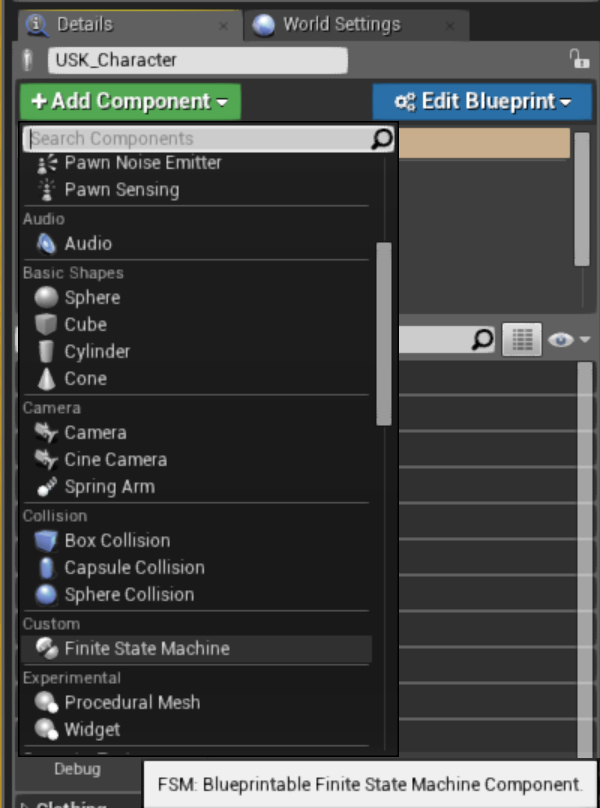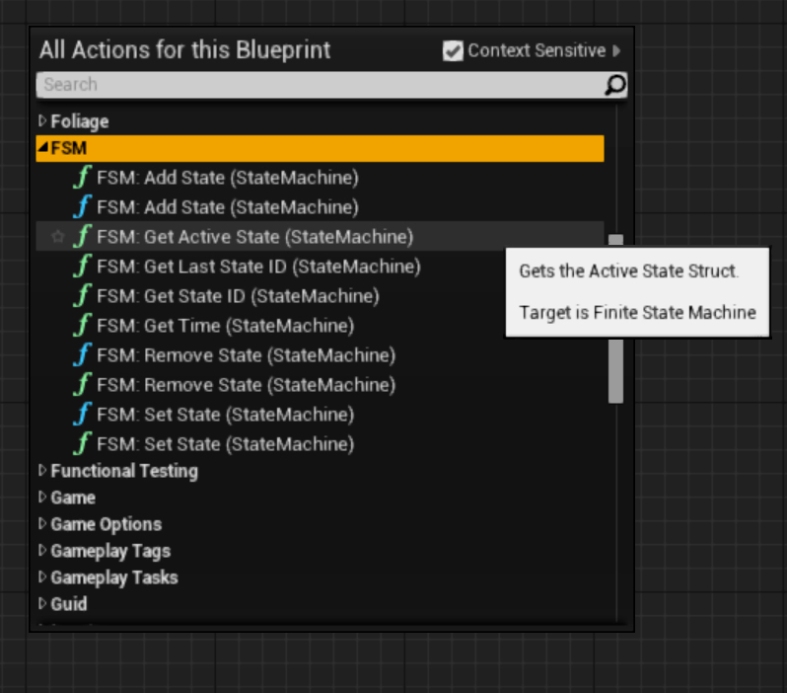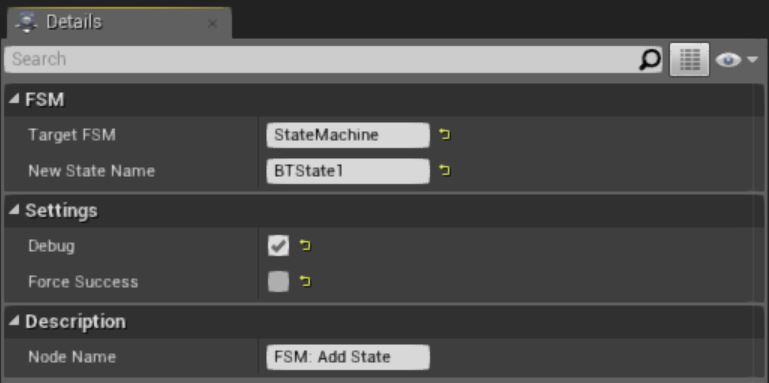I’ve developed a new UE4 Plugin. Simple, yet powerful, Finite State Machine system which allows you to manipulate Actor States through Animation Graph’s State Machines, Behavior Tree Tasks, Blueprint Graphs, or C++ Native Code.
Finite State Machines allows for more logic encapsulation and cleaner code architecture in general, drawing systems design and debugging easier on the long run.
Some Features:
* Blueprintable Finite State Machine System.
* Blueprint Actor Component Based.
* Event-Based Tasks/Actions can be Broadcasted.
* Supports Enumerators as State ID.
* Supports Runtime State-Machine Creation/Deletion.
* Supports Runtime State-Machine Event Bindings.
* State Machines can Tick and Track Update Time.
* FSM Properties can be Replicated.
* Get/Set States from C++, Blueprints, Animation Graphs, Behavior Trees.
How to use:
* First, get the Plugin (not published yet :p) for your compatible Unreal Engine 4 version and install it. After successful installation, you’ll be able to use the FSM Component and its link interfaces. Add to your Actor a FSM Component and you’re good to go.
The Component:
* Launch UEditor and pick an Actor which you want to use FSM with;
From the default Details panel, click ‘Add Component’ drop-down and from the ‘Custom’ group select ‘Finite State Machine’ component; Give it a name.

Blueprint Graph Usage:
* From your Blueprint’s Graph, Component tab, select the State Machine and then you can see in Details panel under the ‘Events’ group there’s now three items: ‘On Begin’, ‘On Update’ and ‘On Exit’.

Clicking one of those Events, then you can attach Blueprint Functions to execute bound to each of them and query for current State ID or Name. The buttons adds a custom Event attached the the FSM Component, since State IDs are unsigned bytes, you can create Blueprint Enumerators and compare against IDs for good code readability.


* Blueprints that have the FSM Component attached also have access to all its Get/Set/Remove State functions as well. You can Add/Remove States any time, in running game, not just in Editor.

Animation Graph Usage:
* If you wish so, you can make a FSM Component reflect a State Machine inside an Animation Blueprint. This however applies only to Skeletal Characters.
Animation Graph’s State Machine Editor is great to setup a FSM and keep a complete visual reference of how your FSM behaves. To do so, you create an Animation Blueprint as usual for your Skeletal Asset, but instead of choosing AnimInstance as Parent Class, pick ‘StateMachineABP’.


* That way your Character can set FSM States based on its Animation States while you react to State changes from your Character Blueprint easily. Once you have your new Animation Blueprint set, in ‘Class Defaults’ you can dictate which FSM Component syncs to Graph and which Animation’s State Machine you want to link.


* Once ‘Override FSM’ in Details panel is enabled, the FSM Component attached to your Character Blueprint will automatically replicate and follow the States from Animation Graph every time it changes. This requires you to use in Character Blueprint the Animation Blueprint Class you have your State-Machines, of course; But you can create multiple State-Machines inside Animation Blueprints for a variety of purposes so this doesn’t affect workflow for the actual Animation States, simply create a dull Machine for FSM Graphs without any code affecting the skeletal entity.


Behavior Trees Usage:
* You can also manipulate FSM States within an AI Controller’s Behavior Tree Board. Using the custom Task nodes: ‘Add State’, ‘Set State’, ‘Check State’, and ‘Remove State’, you can easily make your AI dictate FSM Component’s States based on AI decisions. This is also an awesome way to easily make your AI react to changes within an Animation Blueprint’s State or react to changes within a Character Blueprint’s Events.


Native Code Usage:
* So you are more of a C++ guy?! No problem, setting up a complex FSM within a C++ Class is as simple as creating sub-objects. An additional power you have from Native Code is you can bind Functions to FSM States, directly.

You can bind a new Function to States during runtime, or unbind Functions from it while the game is running as well. You can also easily manipulate States by State Name, State IDs or even directly compare against Enumerator types, with very simple lines of code, such as:

[At 1.3+: StateMachine->SetActive(true,false); is required to activate FSM]
C++ Character Class example, using the API from UFSM 1.6.0+ :
https://wiki.unrealengine.com/FSM#FSM:_.28C.2B.2B.29_Native_API
Final Note:
* With a little bit of imagination, this little tool provides unlimited possibilities! Thanks to the awesome environment provided by Epic Games and their Unreal Engine 4.
If you’re used to work with State Machines, such as Unity PlayMaker, you’ll quickly adapt to the workflow proposed by this Plugin; You can really encapsulate all code logic into Finite State rules. If you never tried FSMs before to build game logic, it will set you free of infinite spaghetti piles of code on the long run, give it a try!
Thanks for sharing this amazing plugin. I would really appreciate it if you make a real scenario tutorial. How would I approach making e.g. player move based on mouse input ?
LikeLike
There’s an example character controller in this post:
https://brunoxavierleite.wordpress.com/2016/08/05/fsm-based-character-in-ue4/
LikeLike
Looks good, I hope it can support complex AI and IK
LikeLike